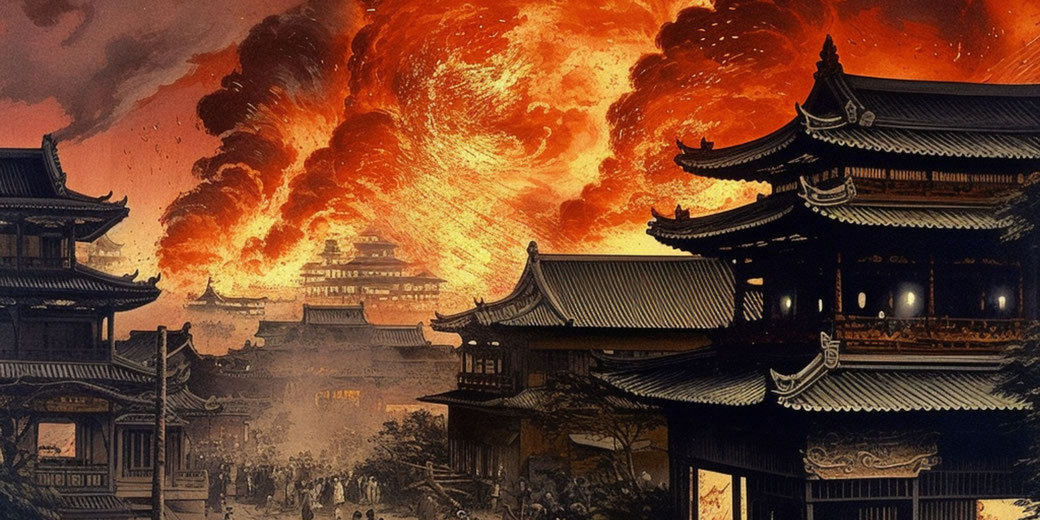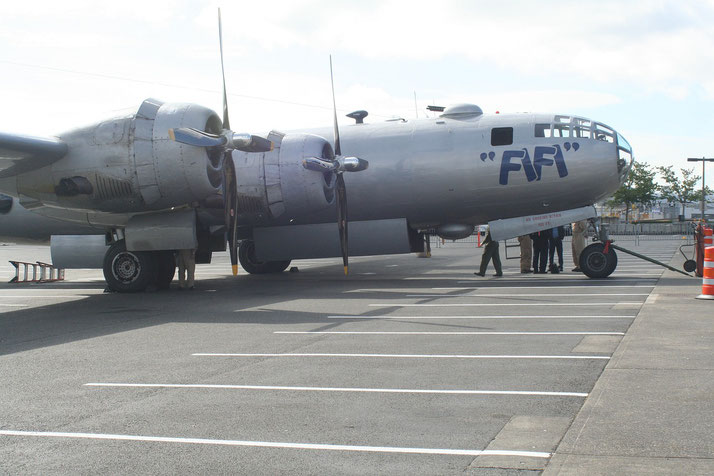Aerial inferno: The devastating firebombing of Tokyo in the closing stages of WWII

Bathed in an inferno that turned night into day, Tokyo, the beating heart of Imperial Japan, was transformed into a desolate landscape of ash and rubble on the fateful night of March 9, 1945.
The city, once teeming with life and symbols of Japan's modernity, bore witness to one of the most devastating events of World War II: the firebombing known as Operation Meetinghouse.
This tragic chapter in human history raises profound questions about the nature of war, the cost of conflict, and the path to recovery.
How did the circumstances of the time lead to this catastrophic event?
How did the international community react, and what ethical debates did the event provoke?
And finally, how did Tokyo rise from the ashes to become the dynamic metropolis we know today?
Japan's role in WWII
The firebombing was not an isolated event, but a part of the broader matrix of World War II and, specifically, the war in the Pacific.
The global stage was dramatically set in the early 20th century with increasing tensions among major powers.
By the 1930s, Japan, driven by its military and imperial ambitions, embarked on a path of expansion, invading Manchuria in 1931 and later China in 1937.
These actions set the stage for Japan's entrance into World War II on the side of the Axis powers, characterized by its surprise attack on the American naval base at Pearl Harbor in December 1941.
This audacious attack pulled the United States into the war, igniting a fierce Pacific conflict that would last until 1945.
As the Pacific War progressed, Tokyo’s role as the political, economic, and symbolic center of Japan's military empire became increasingly evident.
By the early 1940s, Tokyo was a flourishing metropolis and a vital nerve center of the Japanese war effort, directing the operations across vast conquered territories.
It was, in many ways, the heart of Japan and an essential part of the nation's identity, rendering it a significant target in the eyes of the United States military strategists.
The U.S. had already been employing a strategy of aerial bombing against Japan, but the approach until then was primarily focused on strategic bombing — targeting military installations, factories, and transportation networks to cripple Japan's war capacity.
However, by early 1945, this strategy had failed to bring about Japan's surrender. This impasse led the U.S. military to adopt a more aggressive and controversial approach: area bombing, aimed at annihilating entire urban areas and breaking the morale of the civilian population.
The firebombing of Tokyo, therefore, marked a strategic shift, and the city's destiny would be forever altered by what transpired on the fateful night of March 9, 1945.
Operation Meetinghouse: Planning the firebombing
The firebombing of Tokyo, codenamed Operation Meetinghouse, was an audacious mission that marked a pivotal point in the Pacific War.
The operation was planned meticulously, centered around a strategy of maximizing destruction and inflicting psychological terror on the civilian population.
The U.S. Army Air Forces' strategy entailed using the formidable B-29 Superfortress bombers, capable of carrying heavy loads and flying at high altitudes.
For Operation Meetinghouse, however, the bombers would fly at relatively low altitudes, laden with incendiary bombs filled with napalm — a highly flammable compound that would result in an uncontrollable and deadly firestorm.
The decision to switch to low-altitude night bombing was risky, but it was deemed necessary to increase the accuracy of attacks and overcome challenges posed by Japan's weather and strong high-altitude winds.
The night of March 9, 1945, marked the commencement of the operation. An initial wave of bombers was sent to mark the city with fire, creating a burning 'X' that guided the rest of the fleet.
Following this, approximately 279 B-29s, each carrying around six to seven tons of incendiaries, unleashed a rain of fire on Tokyo.
The dense, primarily wooden residential districts of Tokyo turned into a vast, wind-swept firestorm.
Within hours, the firebombing resulted in a conflagration that was one of the most destructive bombing raids in human history.

The scale and intensity of the firestorm was such that it consumed oxygen at an alarming rate, leading to the creation of a super-heated vacuum that generated winds strong enough to uproot trees and suck people into the flames.
Amidst this incandescent vortex, conventional firefighting efforts were virtually impotent, and the blaze raged uncontrollably, wiping out large swathes of Tokyo.
The horrific civilian slaughter of the bombings
In the immediate aftermath of the firebombing, Tokyo was a city transformed. The once vibrant metropolis lay in ashes, a chilling testament to the devastating power of modern warfare.
It was a landscape of charred buildings, rubble-strewn streets, and silent ruins, bearing little resemblance to the thriving city that had existed just hours before.
The human cost of the firebombing was catastrophic. Approximately 100,000 lives were lost, with an even larger number of people injured or maimed.
The majority of these casualties were civilians, including women, children, and the elderly, who had little to no involvement in the war effort.
Furthermore, the firebombing resulted in the displacement of an estimated one million residents, many of whom were rendered homeless overnight, compounding the tragedy with a humanitarian crisis.
Moreover, the physical devastation was extensive. Roughly 16 square miles of the city were destroyed, with more than a quarter of Tokyo's buildings burnt to the ground.
This included not just homes but also schools, hospitals, and places of work, disrupting every aspect of life in the city.
The firebombing left the city's infrastructure in ruins, with its transportation, sanitation, and communication networks severely damaged, pushing Tokyo to the brink of functional collapse.
The response of the Japanese government and military was marked by shock and resolve.
The scale of the disaster overwhelmed emergency services, and resources for aid, already stretched thin by the war, were desperately insufficient.
Despite the immense tragedy, the government remained steadfast in their refusal to surrender, even as the scale of devastation pointed to the increasingly desperate situation facing Japan.
Did the bombings have the intended effect?
The firebombing of Tokyo, while a singularly horrific event, had repercussions far beyond its immediate aftermath.
The wider impact of this event can be seen not only in the trajectory of the Pacific War, but also in the global and domestic reactions to this new form of warfare.
On the Japanese front, the firebombing significantly impacted the morale and resolve of the population.
The destruction of Tokyo, seen by many as the invincible heart of Japan, was a profound psychological blow.
Yet, it did not bring about the desired effect of forcing an immediate Japanese surrender.
Instead, it often hardened the resolve of the Japanese people and their military leaders to resist the Allied forces, even in the face of escalating bombing campaigns and imminent defeat.
Internationally, the reactions to the firebombing were mixed. While some saw it as a necessary step towards ending the war, others decried the strategy of targeting civilian populations.
These ethical debates raged amongst political leaders, military strategists, and the general public alike.
Over time, the firebombing of Tokyo, along with similar bombings in other Japanese cities, sparked an international dialogue on the moral limits of warfare and the protection of civilian populations — a dialogue that would later inform the Geneva Conventions and other international laws of war.
In terms of military strategy, the perceived success of Operation Meetinghouse led to a significant increase in the use of firebombing in the Pacific War.
Major Japanese cities such as Osaka, Nagoya, and Kobe faced similar fates, and the escalation of bombing campaigns culminated in the dropping of atomic bombs on Hiroshima and Nagasaki in August 1945.
The post-war reconstruction of modern Tokyo
In the aftermath of the firebombing and subsequent end of World War II, Tokyo faced the monumental task of rising from its ashes.
The once-thriving city was reduced to ruins, its infrastructure decimated, its economy in shambles, and its population traumatized.
However, the resilience of its citizens and the determination of the Japanese government and international community to rebuild laid the foundation for a remarkable recovery.
Assessing the damage was the first step in the reconstruction process. Government and civic bodies undertook the painstaking task of mapping out the devastated city and estimating the necessary resources for rebuilding.
The challenge was not merely to reconstruct what had been lost, but to rethink and redesign the city to accommodate a rapidly changing post-war society.
The economic impact of the firebombing was severe. Tokyo, the heart of Japan's economy, was crippled, and the nationwide resources were strained due to the overall devastation wrought by the war.
The financial burden of reconstruction was immense. Nonetheless, the Japanese government, with assistance from the United States and other international allies during the occupation period, initiated policies and programs aimed at economic revival.
By the 1950s, these efforts had begun to bear fruit, leading to a period of rapid economic growth, often referred to as the "Japanese economic miracle."
The psychological and societal effects on the survivors, known as hibakusha, were profound.
Many bore the physical and psychological scars of the bombing, grappling with trauma and loss even as they contributed to the rebuilding efforts.
The experiences of the survivors played a critical role in shaping post-war Japanese culture and society, fostering a collective memory marked by a deep desire for peace and a rejection of war.
In less than a decade, Tokyo had remarkably resurrected itself from the ruins, its skyline once again brimming with buildings and its streets bustling with life.
Was the mass killings of civilians morally justified?
The firebombing of Tokyo has left a lasting legacy, influencing historical perspectives, shaping cultural memory, and sparking enduring debates around the ethics of war.
Its impact is not confined to history books but continues to reverberate in the collective consciousness of Japan and the world.
One of the most significant legacies of the firebombing is the ethical debates it has spurred.
While some view it as a necessary evil to hasten the end of World War II, others see it as a war crime, given the vast civilian casualties and the disproportionate scale of destruction.
These debates have broadened our understanding of war's ethical boundaries, contributing to the development of international humanitarian laws and conventions that seek to protect civilians in times of war.
The firebombing also deeply influenced post-war Japanese policy and culture. Japan's post-war constitution, often referred to as the "Postwar Constitution" or the "Constitution of Japan," renounced war and the use of force as a means of settling international disputes.
This pacifist stance is, in part, a response to the devastation experienced in events such as the firebombing.
Culturally, the trauma of the firebombing has found expression in literature, cinema, and the arts, serving as a powerful tool for collective remembering and warning against the horrors of war.
Events such as the Tokyo Air Raids and War Damage Center offer platforms for survivors to share their stories, ensuring that subsequent generations remember and learn from the past.
Public commemorations and monuments, like the Memorial Hall for the Victims in Tokyo, also serve as a reminder of the tragic event, fostering a culture of peace and non-violence.
Each year, memorial ceremonies are held to honor the victims, and the location where the most intense fire occurred is now a park named "Peace Park."
What do you need help with?
Download ready-to-use digital learning resources
Copyright © History Skills 2014-2025.
Contact via email
With the exception of links to external sites, some historical sources and extracts from specific publications, all content on this website is copyrighted by History Skills. This content may not be copied, republished or redistributed without written permission from the website creator. Please use the Contact page to obtain relevant permission.





